In which Sid and Doris visit one of the USA’s largest ports and begin to engage with the history of the Revolution.
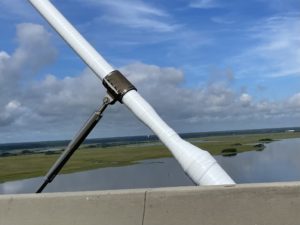 Leaving Jekyll Island is all about the bridges and causeways to get back to the mainland. This bridge has been reinforced with what look like dampers and Sid wonders if they had a ‘bouncy bridge’ problem as we did with London’s Millenium Bridge. Some research finds these are to prevent hurricane winds setting up destructive resonances that whip bridges to pieces.
Leaving Jekyll Island is all about the bridges and causeways to get back to the mainland. This bridge has been reinforced with what look like dampers and Sid wonders if they had a ‘bouncy bridge’ problem as we did with London’s Millenium Bridge. Some research finds these are to prevent hurricane winds setting up destructive resonances that whip bridges to pieces.
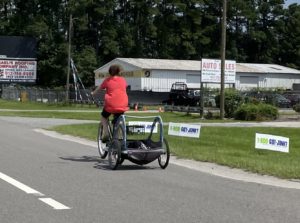 There are many signs requiring traffic to look out for bikes on bridges, and generally to give priority to bikes when turning right. We have seen very few bikes but spot one coming into Savannah. Perhaps this is the bike equivalent of the ubiquitous pick-up?
There are many signs requiring traffic to look out for bikes on bridges, and generally to give priority to bikes when turning right. We have seen very few bikes but spot one coming into Savannah. Perhaps this is the bike equivalent of the ubiquitous pick-up?
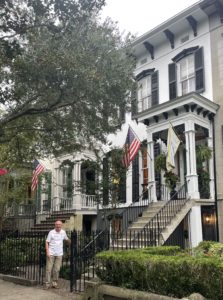 On finding the Justine Inn, our historic quarter B&B, Sid takes host Tony for a trip around the block to find Mr Jolly’s parking spot. Tony and friends have a collection of 1950s Bentleys and a 1962 Mustang that they do not take out of town for fear they will break down. Many congratulations to Matt and Stephan for the JGG’s reliability.
On finding the Justine Inn, our historic quarter B&B, Sid takes host Tony for a trip around the block to find Mr Jolly’s parking spot. Tony and friends have a collection of 1950s Bentleys and a 1962 Mustang that they do not take out of town for fear they will break down. Many congratulations to Matt and Stephan for the JGG’s reliability.
The first trip out is down to the Savannah River. We are a long way from the sea and the channel requires constant dredging well out into the Atlantic. Shipping supports about 500,000 local jobs which will be protected by bringing in New Panamax scale ships which carry three times as many containers but draw 15 metres rather than 12, according to the detailed information panel provided by the dredging project engineers.
 Walking around Savannah is very pleasant with great oaks with the Spanish moss hanging down. The town was laid out on a grid system with 24 park squares open to all to walk through, a great contrast to London where they are often fenced in for exclusive use of the households on the square. (Who don’t.)
Walking around Savannah is very pleasant with great oaks with the Spanish moss hanging down. The town was laid out on a grid system with 24 park squares open to all to walk through, a great contrast to London where they are often fenced in for exclusive use of the households on the square. (Who don’t.)
Savannah feels of a piece with much of the building being pre 1861 but post the fires of 1796 and 1821. The city has been lucky in coming through the Revolutionary and Civil wars undamaged, surrendered intact to Sherman though the economy had been wrecked by the Union blockade of the port. The city struggled through the Reconstruction and Depression coming back to prosperity in the 1950s the old quarter was threatened with redevelopment. The ladies of the Historic Savannah Foundation are now credited with saving the architecture and layout we now enjoy.
In 1732 Georgia was the last British colony founded in America and Savannah was its first city. At the time it was a buffer between South Carolina and the Spanish in Florida. The founders got on well with the local Yamacraw. The colony originally had no slavery though early ordinances forbid Catholicism. John Wesley came and was Pastor at Christ Church from 1735 to 1737, leaving after some awkwardness with Sophia Hockey whom he denied Communion, she having married another and therefore – he felt – possibly lost interest in God.
 The Catholics came anyway and though God burned down their Cathedral several times they persevered and built what is now the Minor Basilica of John the Baptist. The slim pillars are iron.
The Catholics came anyway and though God burned down their Cathedral several times they persevered and built what is now the Minor Basilica of John the Baptist. The slim pillars are iron.
The British held Savannah throughout the Revolutionary Wars (1775 – ‘83) so the city was intact at Independence. However, Georgia cotton from non-slave plantations was uncompetitive so the state legalised slavery. Much of the world’s crop traded by the dock at the Savannah Cotton Exchange. Georgia was then one of the first states to secede.
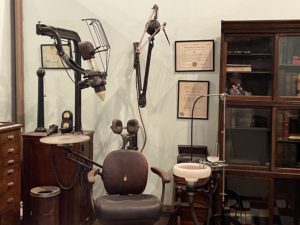 The city museum does a very good job of putting all of this into order and context, as well as including this scary exhibit of an entire dentist’s surgery which only closed for business in 1980, still using the equipment that he had bought in 1918. Oh, with the dangerously modern addition of the Xray device bought in 1931.
The city museum does a very good job of putting all of this into order and context, as well as including this scary exhibit of an entire dentist’s surgery which only closed for business in 1980, still using the equipment that he had bought in 1918. Oh, with the dangerously modern addition of the Xray device bought in 1931.
On the day we visited, the railway part of the museum was shut for clearing up after filming a series about Zombies, not Amtrak obviously. Happily a docent had brought photos to help tell the story of railways in Savannah, clearly very important with all that produce to move to the port.
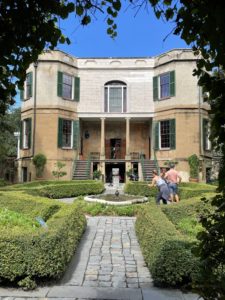 The day we leave Savannah we visit the Owens-Thomas House. This is set up to tell a balanced story of a large house, built for a family who get rich on the labour of enslaved people, who also work in the house, though their rooms are more crowded and have no plumbing.
The day we leave Savannah we visit the Owens-Thomas House. This is set up to tell a balanced story of a large house, built for a family who get rich on the labour of enslaved people, who also work in the house, though their rooms are more crowded and have no plumbing.
The Marquis of Lafayette – the last surviving major general of the Revolution visited Savannah in 1825. An information board in the house says that he told a friend, “I would never have drawn my sword in the cause of America if I could have conceived that thereby I was founding a land of slavery!”
S and D feel like this may be a fitting end to their Southern House Visits.
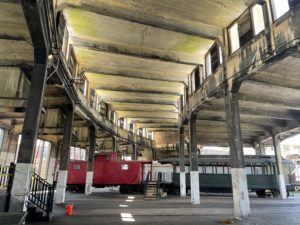 Driving out of the city we pass the railroad museum which now seems to be gore-free and open. Doris dupes “non-stop” Sid into circling back to it and we get on with gorming some proper 19th and 20th century engineering.
Driving out of the city we pass the railroad museum which now seems to be gore-free and open. Doris dupes “non-stop” Sid into circling back to it and we get on with gorming some proper 19th and 20th century engineering.
Quite a lot of the railway works has been sold off. The best bits remaining are around the roundhouse, and while it is not full of steam locomotives there are some, plus a diesel and carriages to fill the place out and keep them under cover. The turntable still works, so it will be possible to get out the locos that they seem to be restoring.
 They are wondering if they can afford to (re-)build this coach transfer device. A coach is shunted onto the rails that you cannot clearly see between each of the wheel sets. The whole contraption is then rolled along by the engine in the control hut until it is opposite the doors in the carriage maintenance workshop in the back right of the picture. S and D have never seen one but could imagine mocking one up in OO scale.
They are wondering if they can afford to (re-)build this coach transfer device. A coach is shunted onto the rails that you cannot clearly see between each of the wheel sets. The whole contraption is then rolled along by the engine in the control hut until it is opposite the doors in the carriage maintenance workshop in the back right of the picture. S and D have never seen one but could imagine mocking one up in OO scale.
The road out of town brings the JGG face to face with a large diesel pulling a double height freight train as it approaches a very bumpy level crossing.
It has a light on and it is clanging its bell, though the gates have not yet come down. Sid stops but people behind hoot frantically and the JGG – and as many as possible of the cars behind it – gets across before the long and slow-moving train triggers the gates and the others settle in for a nice rest.
 All along the road are logistics yards with some of the thousands of TEUs, mostly 40 footers, that have come off ships and are waiting for trains and trucks.
All along the road are logistics yards with some of the thousands of TEUs, mostly 40 footers, that have come off ships and are waiting for trains and trucks.
The Duo set off from Savannah with the view they have seen enough Ante Bellum interiors and cabins for enslaved people. Perhaps enough muskets, too.
Happily Charleston has something else to offer.


Where’s the picture of the cake?!
Happy Birthday, Doris 😁